Applying Erikson's Theory: A Detailed Case Study on Child Development
VerifiedAdded on 2023/06/03
|6
|1493
|351
Case Study
AI Summary
This case study examines the development of a 2-year-old girl named Julie, using Erik Erikson's theory of psychosocial development, particularly focusing on the autonomy vs. shame and doubt stage. Julie's mother, Victoria, is concerned about her daughter's lack of toilet training compared to other children her age. The analysis suggests that Victoria's potential lack of attention during Julie's earlier stages and her current discouraging behavior may be contributing to Julie's developmental challenges. The case study emphasizes the importance of a supportive and encouraging environment for a child's development and suggests that Victoria's positive behavior and dedicated quality time could help Julie overcome her challenges and build self-confidence. The nursing personnel recommended Victoria to join a local mother’s group so that she can discuss the problem of her daughter’s behavior with mothers. The study concludes that parental support and attention are crucial for promoting healthy child development, and Desklib provides similar solved assignments for students.
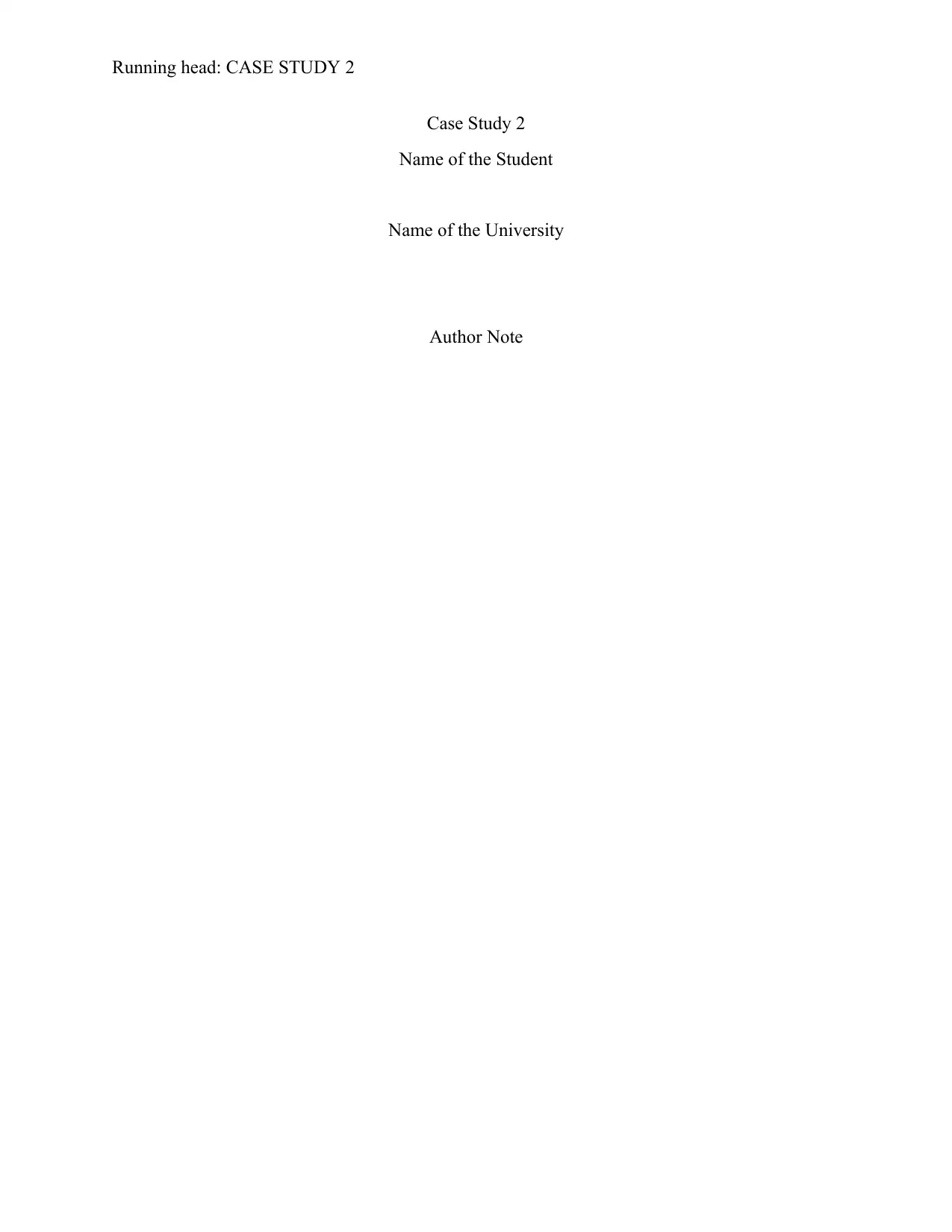
Running head: CASE STUDY 2
Case Study 2
Name of the Student
Name of the University
Author Note
Case Study 2
Name of the Student
Name of the University
Author Note
Paraphrase This Document
Need a fresh take? Get an instant paraphrase of this document with our AI Paraphraser
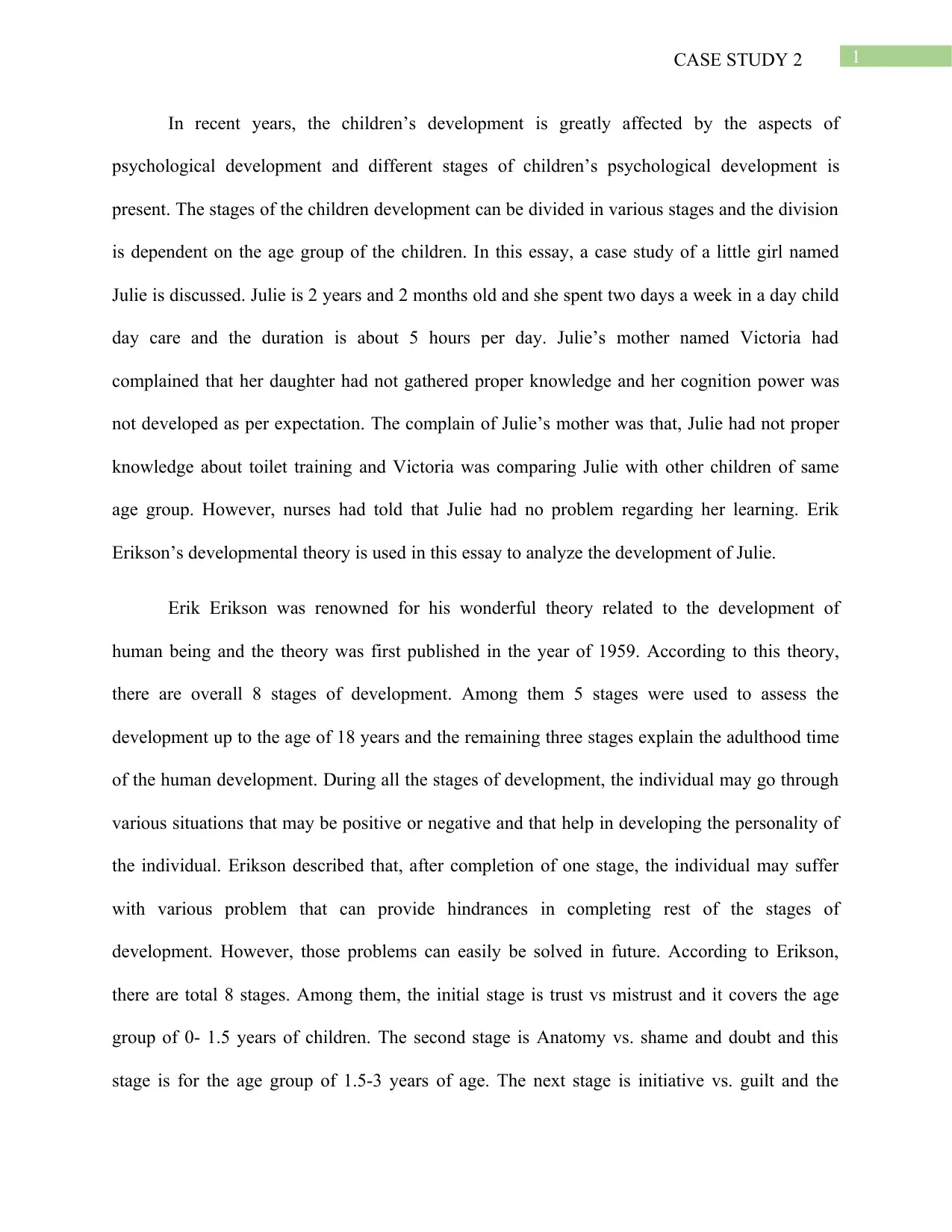
1CASE STUDY 2
In recent years, the children’s development is greatly affected by the aspects of
psychological development and different stages of children’s psychological development is
present. The stages of the children development can be divided in various stages and the division
is dependent on the age group of the children. In this essay, a case study of a little girl named
Julie is discussed. Julie is 2 years and 2 months old and she spent two days a week in a day child
day care and the duration is about 5 hours per day. Julie’s mother named Victoria had
complained that her daughter had not gathered proper knowledge and her cognition power was
not developed as per expectation. The complain of Julie’s mother was that, Julie had not proper
knowledge about toilet training and Victoria was comparing Julie with other children of same
age group. However, nurses had told that Julie had no problem regarding her learning. Erik
Erikson’s developmental theory is used in this essay to analyze the development of Julie.
Erik Erikson was renowned for his wonderful theory related to the development of
human being and the theory was first published in the year of 1959. According to this theory,
there are overall 8 stages of development. Among them 5 stages were used to assess the
development up to the age of 18 years and the remaining three stages explain the adulthood time
of the human development. During all the stages of development, the individual may go through
various situations that may be positive or negative and that help in developing the personality of
the individual. Erikson described that, after completion of one stage, the individual may suffer
with various problem that can provide hindrances in completing rest of the stages of
development. However, those problems can easily be solved in future. According to Erikson,
there are total 8 stages. Among them, the initial stage is trust vs mistrust and it covers the age
group of 0- 1.5 years of children. The second stage is Anatomy vs. shame and doubt and this
stage is for the age group of 1.5-3 years of age. The next stage is initiative vs. guilt and the
In recent years, the children’s development is greatly affected by the aspects of
psychological development and different stages of children’s psychological development is
present. The stages of the children development can be divided in various stages and the division
is dependent on the age group of the children. In this essay, a case study of a little girl named
Julie is discussed. Julie is 2 years and 2 months old and she spent two days a week in a day child
day care and the duration is about 5 hours per day. Julie’s mother named Victoria had
complained that her daughter had not gathered proper knowledge and her cognition power was
not developed as per expectation. The complain of Julie’s mother was that, Julie had not proper
knowledge about toilet training and Victoria was comparing Julie with other children of same
age group. However, nurses had told that Julie had no problem regarding her learning. Erik
Erikson’s developmental theory is used in this essay to analyze the development of Julie.
Erik Erikson was renowned for his wonderful theory related to the development of
human being and the theory was first published in the year of 1959. According to this theory,
there are overall 8 stages of development. Among them 5 stages were used to assess the
development up to the age of 18 years and the remaining three stages explain the adulthood time
of the human development. During all the stages of development, the individual may go through
various situations that may be positive or negative and that help in developing the personality of
the individual. Erikson described that, after completion of one stage, the individual may suffer
with various problem that can provide hindrances in completing rest of the stages of
development. However, those problems can easily be solved in future. According to Erikson,
there are total 8 stages. Among them, the initial stage is trust vs mistrust and it covers the age
group of 0- 1.5 years of children. The second stage is Anatomy vs. shame and doubt and this
stage is for the age group of 1.5-3 years of age. The next stage is initiative vs. guilt and the
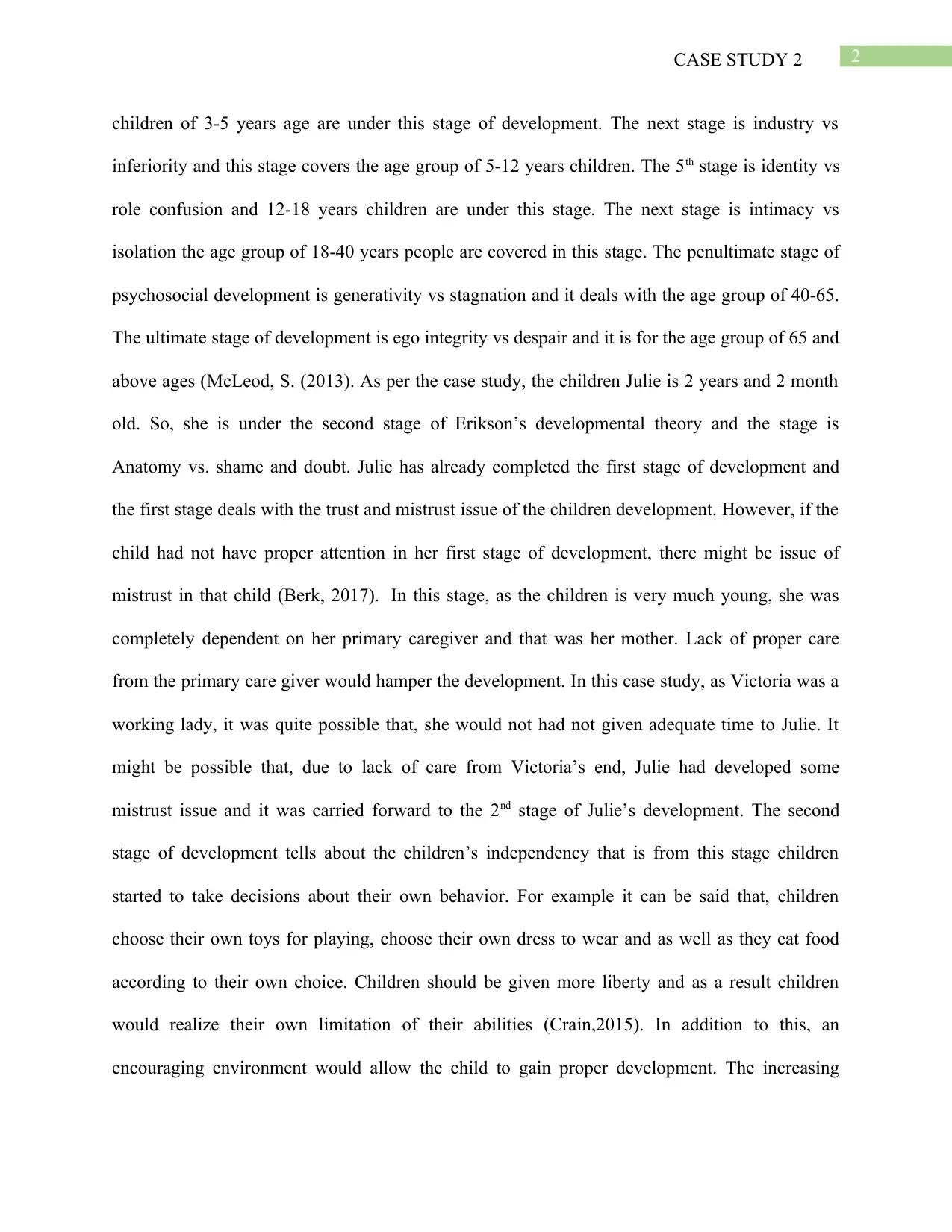
2CASE STUDY 2
children of 3-5 years age are under this stage of development. The next stage is industry vs
inferiority and this stage covers the age group of 5-12 years children. The 5th stage is identity vs
role confusion and 12-18 years children are under this stage. The next stage is intimacy vs
isolation the age group of 18-40 years people are covered in this stage. The penultimate stage of
psychosocial development is generativity vs stagnation and it deals with the age group of 40-65.
The ultimate stage of development is ego integrity vs despair and it is for the age group of 65 and
above ages (McLeod, S. (2013). As per the case study, the children Julie is 2 years and 2 month
old. So, she is under the second stage of Erikson’s developmental theory and the stage is
Anatomy vs. shame and doubt. Julie has already completed the first stage of development and
the first stage deals with the trust and mistrust issue of the children development. However, if the
child had not have proper attention in her first stage of development, there might be issue of
mistrust in that child (Berk, 2017). In this stage, as the children is very much young, she was
completely dependent on her primary caregiver and that was her mother. Lack of proper care
from the primary care giver would hamper the development. In this case study, as Victoria was a
working lady, it was quite possible that, she would not had not given adequate time to Julie. It
might be possible that, due to lack of care from Victoria’s end, Julie had developed some
mistrust issue and it was carried forward to the 2nd stage of Julie’s development. The second
stage of development tells about the children’s independency that is from this stage children
started to take decisions about their own behavior. For example it can be said that, children
choose their own toys for playing, choose their own dress to wear and as well as they eat food
according to their own choice. Children should be given more liberty and as a result children
would realize their own limitation of their abilities (Crain,2015). In addition to this, an
encouraging environment would allow the child to gain proper development. The increasing
children of 3-5 years age are under this stage of development. The next stage is industry vs
inferiority and this stage covers the age group of 5-12 years children. The 5th stage is identity vs
role confusion and 12-18 years children are under this stage. The next stage is intimacy vs
isolation the age group of 18-40 years people are covered in this stage. The penultimate stage of
psychosocial development is generativity vs stagnation and it deals with the age group of 40-65.
The ultimate stage of development is ego integrity vs despair and it is for the age group of 65 and
above ages (McLeod, S. (2013). As per the case study, the children Julie is 2 years and 2 month
old. So, she is under the second stage of Erikson’s developmental theory and the stage is
Anatomy vs. shame and doubt. Julie has already completed the first stage of development and
the first stage deals with the trust and mistrust issue of the children development. However, if the
child had not have proper attention in her first stage of development, there might be issue of
mistrust in that child (Berk, 2017). In this stage, as the children is very much young, she was
completely dependent on her primary caregiver and that was her mother. Lack of proper care
from the primary care giver would hamper the development. In this case study, as Victoria was a
working lady, it was quite possible that, she would not had not given adequate time to Julie. It
might be possible that, due to lack of care from Victoria’s end, Julie had developed some
mistrust issue and it was carried forward to the 2nd stage of Julie’s development. The second
stage of development tells about the children’s independency that is from this stage children
started to take decisions about their own behavior. For example it can be said that, children
choose their own toys for playing, choose their own dress to wear and as well as they eat food
according to their own choice. Children should be given more liberty and as a result children
would realize their own limitation of their abilities (Crain,2015). In addition to this, an
encouraging environment would allow the child to gain proper development. The increasing
⊘ This is a preview!⊘
Do you want full access?
Subscribe today to unlock all pages.

Trusted by 1+ million students worldwide
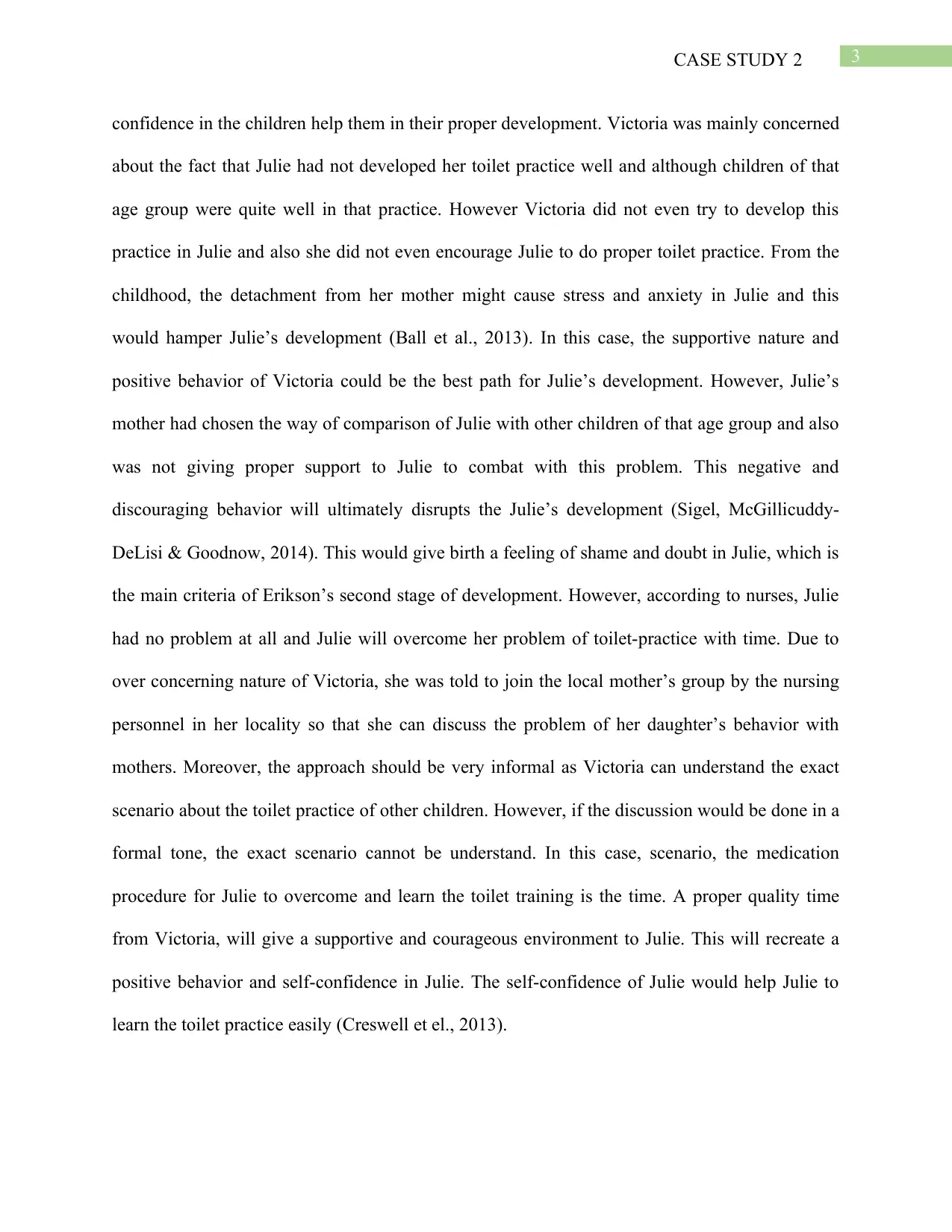
3CASE STUDY 2
confidence in the children help them in their proper development. Victoria was mainly concerned
about the fact that Julie had not developed her toilet practice well and although children of that
age group were quite well in that practice. However Victoria did not even try to develop this
practice in Julie and also she did not even encourage Julie to do proper toilet practice. From the
childhood, the detachment from her mother might cause stress and anxiety in Julie and this
would hamper Julie’s development (Ball et al., 2013). In this case, the supportive nature and
positive behavior of Victoria could be the best path for Julie’s development. However, Julie’s
mother had chosen the way of comparison of Julie with other children of that age group and also
was not giving proper support to Julie to combat with this problem. This negative and
discouraging behavior will ultimately disrupts the Julie’s development (Sigel, McGillicuddy-
DeLisi & Goodnow, 2014). This would give birth a feeling of shame and doubt in Julie, which is
the main criteria of Erikson’s second stage of development. However, according to nurses, Julie
had no problem at all and Julie will overcome her problem of toilet-practice with time. Due to
over concerning nature of Victoria, she was told to join the local mother’s group by the nursing
personnel in her locality so that she can discuss the problem of her daughter’s behavior with
mothers. Moreover, the approach should be very informal as Victoria can understand the exact
scenario about the toilet practice of other children. However, if the discussion would be done in a
formal tone, the exact scenario cannot be understand. In this case, scenario, the medication
procedure for Julie to overcome and learn the toilet training is the time. A proper quality time
from Victoria, will give a supportive and courageous environment to Julie. This will recreate a
positive behavior and self-confidence in Julie. The self-confidence of Julie would help Julie to
learn the toilet practice easily (Creswell et el., 2013).
confidence in the children help them in their proper development. Victoria was mainly concerned
about the fact that Julie had not developed her toilet practice well and although children of that
age group were quite well in that practice. However Victoria did not even try to develop this
practice in Julie and also she did not even encourage Julie to do proper toilet practice. From the
childhood, the detachment from her mother might cause stress and anxiety in Julie and this
would hamper Julie’s development (Ball et al., 2013). In this case, the supportive nature and
positive behavior of Victoria could be the best path for Julie’s development. However, Julie’s
mother had chosen the way of comparison of Julie with other children of that age group and also
was not giving proper support to Julie to combat with this problem. This negative and
discouraging behavior will ultimately disrupts the Julie’s development (Sigel, McGillicuddy-
DeLisi & Goodnow, 2014). This would give birth a feeling of shame and doubt in Julie, which is
the main criteria of Erikson’s second stage of development. However, according to nurses, Julie
had no problem at all and Julie will overcome her problem of toilet-practice with time. Due to
over concerning nature of Victoria, she was told to join the local mother’s group by the nursing
personnel in her locality so that she can discuss the problem of her daughter’s behavior with
mothers. Moreover, the approach should be very informal as Victoria can understand the exact
scenario about the toilet practice of other children. However, if the discussion would be done in a
formal tone, the exact scenario cannot be understand. In this case, scenario, the medication
procedure for Julie to overcome and learn the toilet training is the time. A proper quality time
from Victoria, will give a supportive and courageous environment to Julie. This will recreate a
positive behavior and self-confidence in Julie. The self-confidence of Julie would help Julie to
learn the toilet practice easily (Creswell et el., 2013).
Paraphrase This Document
Need a fresh take? Get an instant paraphrase of this document with our AI Paraphraser
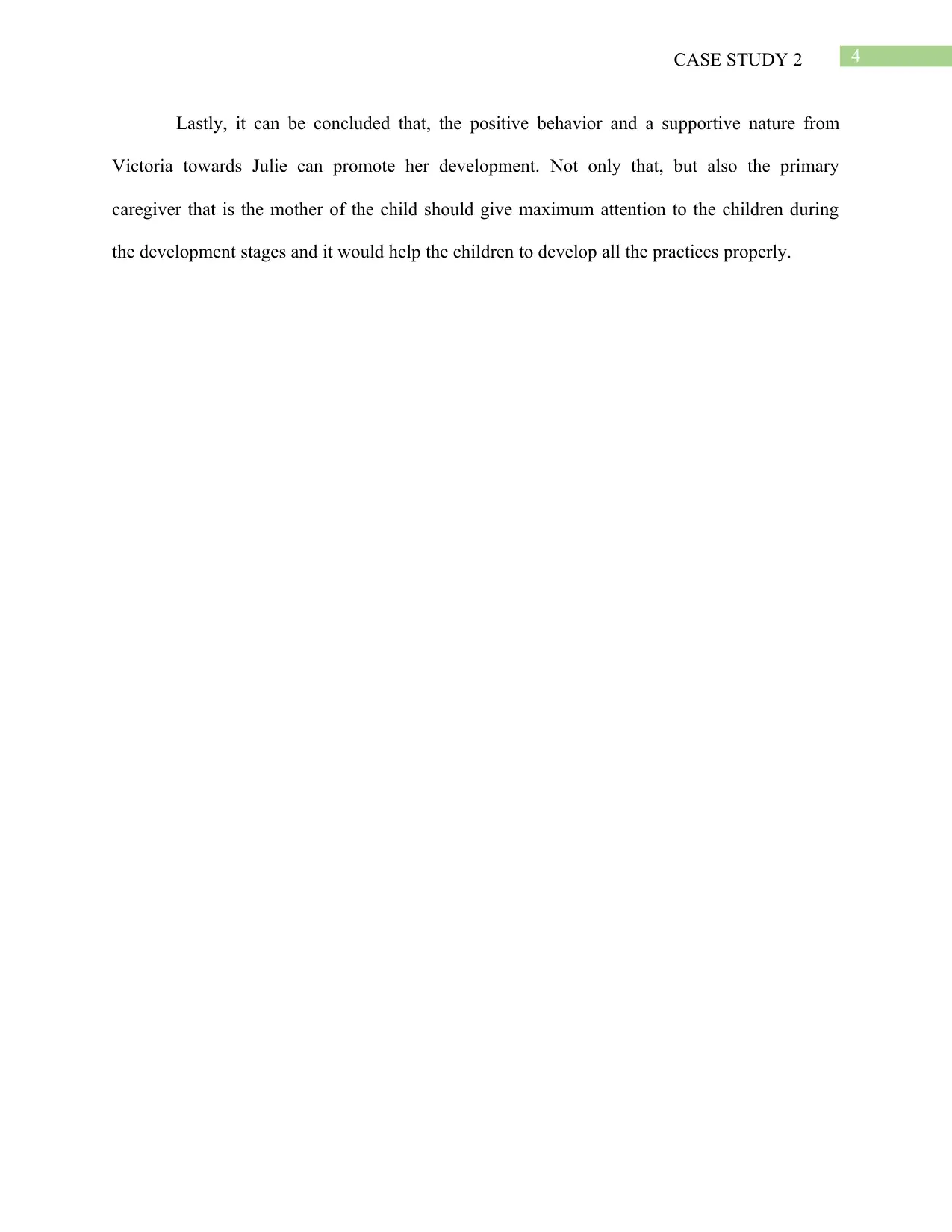
4CASE STUDY 2
Lastly, it can be concluded that, the positive behavior and a supportive nature from
Victoria towards Julie can promote her development. Not only that, but also the primary
caregiver that is the mother of the child should give maximum attention to the children during
the development stages and it would help the children to develop all the practices properly.
Lastly, it can be concluded that, the positive behavior and a supportive nature from
Victoria towards Julie can promote her development. Not only that, but also the primary
caregiver that is the mother of the child should give maximum attention to the children during
the development stages and it would help the children to develop all the practices properly.
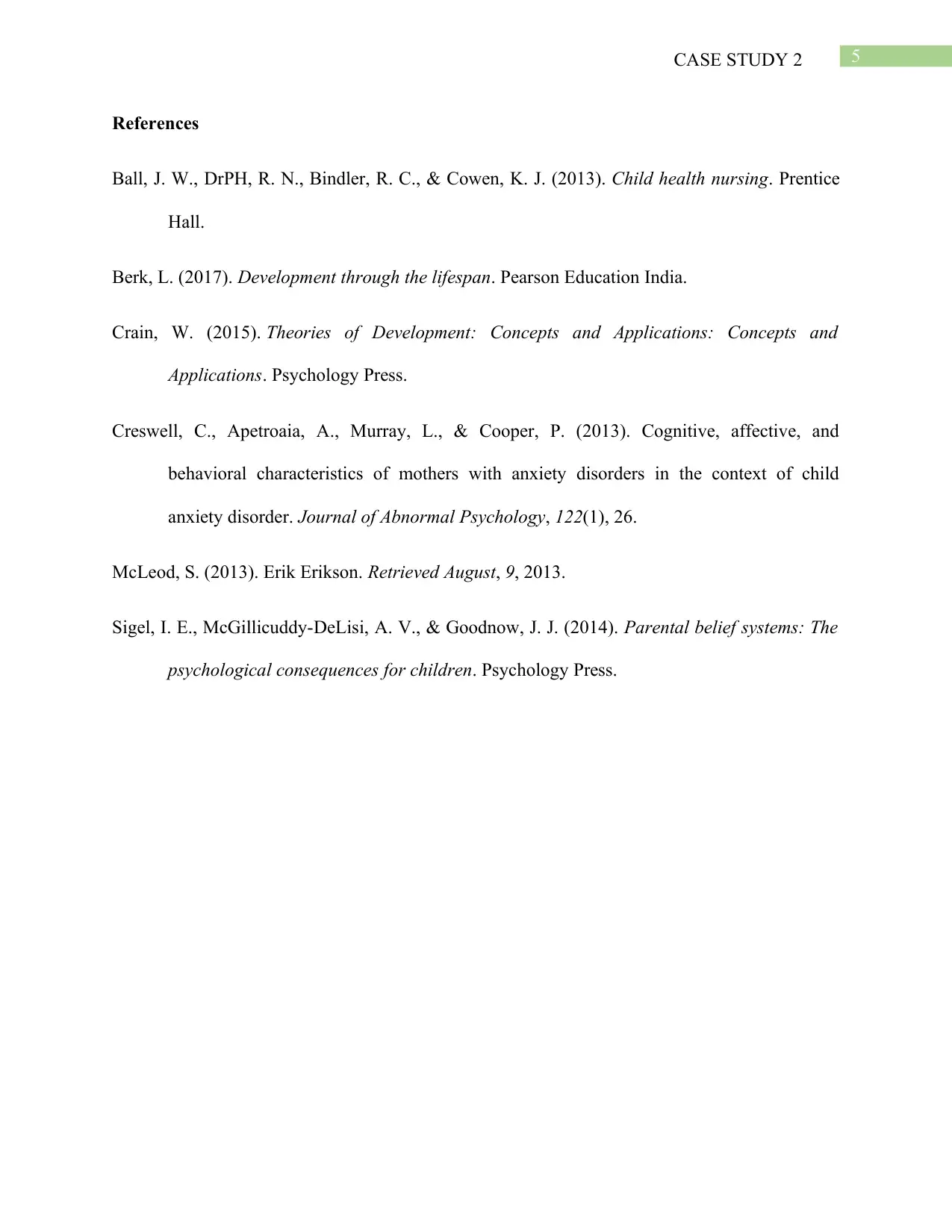
5CASE STUDY 2
References
Ball, J. W., DrPH, R. N., Bindler, R. C., & Cowen, K. J. (2013). Child health nursing. Prentice
Hall.
Berk, L. (2017). Development through the lifespan. Pearson Education India.
Crain, W. (2015). Theories of Development: Concepts and Applications: Concepts and
Applications. Psychology Press.
Creswell, C., Apetroaia, A., Murray, L., & Cooper, P. (2013). Cognitive, affective, and
behavioral characteristics of mothers with anxiety disorders in the context of child
anxiety disorder. Journal of Abnormal Psychology, 122(1), 26.
McLeod, S. (2013). Erik Erikson. Retrieved August, 9, 2013.
Sigel, I. E., McGillicuddy-DeLisi, A. V., & Goodnow, J. J. (2014). Parental belief systems: The
psychological consequences for children. Psychology Press.
References
Ball, J. W., DrPH, R. N., Bindler, R. C., & Cowen, K. J. (2013). Child health nursing. Prentice
Hall.
Berk, L. (2017). Development through the lifespan. Pearson Education India.
Crain, W. (2015). Theories of Development: Concepts and Applications: Concepts and
Applications. Psychology Press.
Creswell, C., Apetroaia, A., Murray, L., & Cooper, P. (2013). Cognitive, affective, and
behavioral characteristics of mothers with anxiety disorders in the context of child
anxiety disorder. Journal of Abnormal Psychology, 122(1), 26.
McLeod, S. (2013). Erik Erikson. Retrieved August, 9, 2013.
Sigel, I. E., McGillicuddy-DeLisi, A. V., & Goodnow, J. J. (2014). Parental belief systems: The
psychological consequences for children. Psychology Press.
⊘ This is a preview!⊘
Do you want full access?
Subscribe today to unlock all pages.

Trusted by 1+ million students worldwide
1 out of 6
Related Documents
Your All-in-One AI-Powered Toolkit for Academic Success.
+13062052269
info@desklib.com
Available 24*7 on WhatsApp / Email
![[object Object]](/_next/static/media/star-bottom.7253800d.svg)
Unlock your academic potential
Copyright © 2020–2025 A2Z Services. All Rights Reserved. Developed and managed by ZUCOL.





